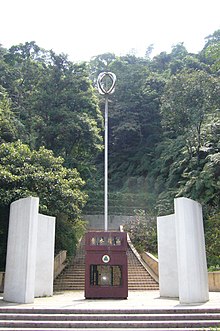Geographic center of Taiwan
臺灣地理中心 | |
 The first Geographic Center of Taiwan Monument | |
 | |
| 23°58′25.9″N 120°58′55.2″E / 23.973861°N 120.982000°E | |
| Location | Mount Hutou, Puli, Nantou County, Taiwan |
|---|---|
| Type | geographical center |
| Geographic center of Taiwan | |||||||||
|---|---|---|---|---|---|---|---|---|---|
| Traditional Chinese | 臺灣地理中心 | ||||||||
| |||||||||
Geographic center of Taiwan is the center point of Taiwan Island. It is located at Mount Hutou (t 虎頭山, s 虎头山, Hutoushan, "Tiger Head Mountain") in the township of Puli in Nantou County, Taiwan.
History
The first Geographic Center of Taiwan monument was constructed at the base of Mount Hutou in the 1970s. Following improved surveying, another monument was built later on, on the peak of the mountain. The peak monument was built on the former site of the Yoshitaka Shrine erected by the Japanese during their occupation of Taiwan.
Architecture
The monument is located on top of 400 stairs leading to it. The base monument features an inscription by former President Chiang Ching-kuo, written as Shan Qing Shui Xiu.[1] There are concentric steel rings on top of the monument pole, forming the basis of Puli Township logo. The peak monument was built in an aboriginal style, using columns with flare tops.
Transportation
The monument is accessible by bus from Taichung Station of Taiwan Railways.[2]
See also
- Geography of Taiwan
- Cape Fugui, the northernmost point on Taiwan
- Eluanbi, the southernmost point on Taiwan
References
- ^ "Geographic Center of Taiwan Monument". Sun Moon Lake. 4 September 2020. Retrieved 27 November 2021.
- ^ "Center of Taiwan Monument (The Stele of Taiwan's Geographical Center)". Taiwan, the Heart of Asia. 28 May 2021. Retrieved 27 November 2021.
External links
 Media related to Taiwan Geographical Center Stele at Wikimedia Commons
Media related to Taiwan Geographical Center Stele at Wikimedia Commons
